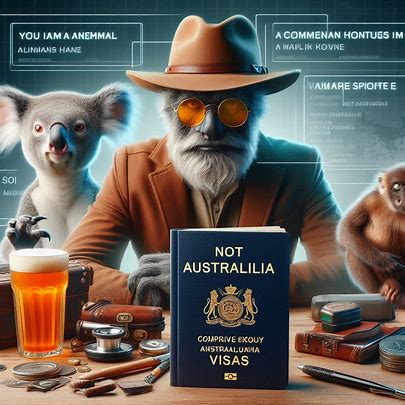Australia, often referred to as the “Land Down Under,” is a top destination for travelers, students, workers, and immigrants from around the globe. With its diverse landscapes, bustling cities, world-class education system, and growing job market, Australia attracts millions of visitors and residents each year. However, anyone planning to enter the country must first navigate Australia’s visa system, which is extensive and designed to accommodate various needs.
This article provides a detailed guide to the different types of Australian visas, how to apply for them, and what travelers and immigrants need to know before embarking on their Australian journey.
Types of Australian Visas
Australia offers a wide variety of visas that cater to different purposes, such as tourism, study, work, business, and permanent residency. Below are some of the most common types of visas available.
1. Tourist Visas
Tourist visas are designed for people who want to visit Australia for short-term holidays, sightseeing, or visiting friends and family. The most common types include:
- Visitor Visa (subclass 600): Allows travelers to visit Australia for tourism, business visitor activities, or to visit family for up to 12 months. It can be applied for from within Australia or overseas.
- Electronic Travel Authority (ETA) Visa (subclass 601): Available for passport holders from certain countries, this visa allows short-term visits to Australia for up to three months for tourism or business purposes. ETAs are usually processed online and approved quickly.
- eVisitor Visa (subclass 651): Available for European Union citizens and other eligible countries, this visa allows for short visits of up to three months for tourism or business purposes.
For more information, you can speak to Happy Face
2. Working Holiday Visas
Australia’s working holiday visas allow young adults (usually aged 18-30, or 35 for some countries) to travel and work in Australia temporarily.
- Working Holiday Visa (subclass 417): This visa is designed for young people from eligible countries, allowing them to work and holiday in Australia for up to 12 months. It also offers the opportunity to extend for an additional year if specific work requirements (such as farm work) are met during the first year.
- Work and Holiday Visa (subclass 462): Similar to the subclass 417 visa, but with a separate list of eligible countries and specific requirements, such as education or language proficiency tests. Like the 417, the subclass 462 visa allows extensions if certain work conditions are met.
3. Student Visas
Australia is one of the top destinations for international students due to its high-quality education system. For those looking to study, the student visa is essential.
- Student Visa (subclass 500): This visa allows international students to study full-time at an Australian educational institution. It covers a wide range of programs, from primary and secondary schooling to higher education, vocational training, and English language courses. The length of stay depends on the duration of the chosen study program, and visa holders are permitted to work up to 40 hours per fortnight during their course.
4. Work Visas
Australia offers several visa options for those wishing to work in the country, ranging from temporary work visas to permanent residency options based on skills and employment.
- Temporary Skill Shortage (TSS) Visa (subclass 482): This visa allows Australian businesses to sponsor skilled workers to fill positions where local talent is unavailable. It has three streams: short-term, medium-term, and labor agreement. The visa duration varies, but it generally allows stays between two and four years.
- Skilled Independent Visa (subclass 189): A points-based visa for skilled workers who are not sponsored by an employer or family member and who do not need state or territory government nomination. It allows for permanent residency and does not require a job offer before applying.
- Skilled Nominated Visa (subclass 190): This points-based visa is for workers who are nominated by an Australian state or territory government. It also grants permanent residency.
- Employer Nomination Scheme (subclass 186): A permanent visa for skilled workers nominated by their employer to live and work in Australia. It is available through the direct entry stream, the labor agreement stream, or the temporary residence transition stream.
For more information, you can speak to Happy Face
5. Business and Investor Visas
Australia offers several visa options for entrepreneurs, investors, and business owners looking to start or manage businesses in the country.
- Business Innovation and Investment Visa (subclass 188): This visa is for individuals who wish to invest or start a business in Australia. It includes various streams such as the Business Innovation stream, Investor stream, and Significant Investor stream, depending on the level of investment or type of business proposed.
- Business Talent (Permanent) Visa (subclass 132): This visa is for high-caliber business owners or individuals with venture capital funding to establish or grow a business in Australia. It grants permanent residency and requires a substantial business history or funding from a venture capital firm.
6. Family Visas
Family visas are designed for people who have relatives in Australia and wish to reunite with them. This includes partners, parents, and other family members.
- Partner Visa (subclasses 820 and 801): These visas allow the spouse or de facto partner of an Australian citizen, permanent resident, or eligible New Zealand citizen to live in Australia. The subclass 820 is a temporary visa, while the subclass 801 grants permanent residency after a set period.
- Parent Visa (subclasses 103, 804, 143, 864): These visas allow parents of Australian citizens or permanent residents to live in Australia. The type of parent visa depends on factors like age and whether the applicant is applying from inside or outside Australia.
- Child Visa (subclass 101): This visa is for children of Australian citizens or permanent residents, allowing them to live with their parents in Australia.
7. Permanent Residency Visas
Permanent residency (PR) visas allow individuals to live in Australia indefinitely, enjoying many of the same rights and privileges as citizens, such as healthcare and education benefits.
- Skilled Independent Visa (subclass 189): As mentioned earlier, this visa is points-based and does not require employer sponsorship or state nomination. It grants permanent residency to skilled workers.
- Partner Visa (subclass 801): The partner visa allows a spouse or de facto partner to live permanently in Australia after being granted the initial temporary visa (subclass 820).
- Regional Sponsored Migration Scheme Visa (subclass 187): This is a permanent visa for skilled workers who want to work in regional Australia and are nominated by an employer.
For more information, you can speak to Happy Face
How to Apply for an Australian Visa
Applying for an Australian visa involves several key steps. While the specific application process may vary depending on the visa type, the general steps are as follows:
- Determine Visa Type: The first step is to determine the appropriate visa based on the purpose of the visit—whether for travel, study, work, or family reunification.
- Check Eligibility: Each visa type has its own eligibility requirements. Some visas are points-based, meaning applicants must meet certain criteria such as age, English proficiency, work experience, and education. Others require sponsorship from an employer or family member.
- Submit an Expression of Interest (EOI): For certain skilled and business visas, applicants must first submit an Expression of Interest through the SkillSelect system. After submitting an EOI, applicants may be invited to apply for a visa based on their points score or other criteria.
- Gather Documents: Depending on the visa, applicants must gather necessary documents such as proof of identity, educational qualifications, work experience, financial statements, or health insurance.
- Submit the Application: Applications for most visas are submitted online via the Australian Department of Home Affairs website. Applicants will need to create an ImmiAccount, where they can track the status of their visa application.
- Pay Fees: Visa application fees vary based on the type of visa. Fees must be paid upon submission of the application, and failure to pay the correct amount can delay the processing.
- Biometrics and Health Checks: In some cases, applicants may be required to provide biometric information (fingerprints and photographs) or undergo a health check to ensure they meet Australian health standards.
- Wait for Approval: Processing times vary depending on the visa type and the complexity of the application. Once approved, the applicant will receive a visa grant notice outlining the conditions of their visa.
For more information, you can speak to Happy Face
Important Things to Consider
- Visa Validity: Make sure to check the length of stay and validity period of the visa to avoid overstaying.
- Work and Study Restrictions: Some visas, such as tourist visas, do not allow working or studying in Australia. Ensure the visa conditions align with your plans.
- Health and Character Requirements: Most Australian visas require applicants to meet certain health and character requirements. This might include undergoing a health check or providing police clearance certificates.
- Visa Extensions: Some temporary visas, such as tourist or working holiday visas, can be extended if certain conditions are met.
Australia offers a diverse range of visa options for tourists, students, workers, investors, and family members. Navigating the visa system can be complex, but understanding the different visa categories, application processes, and eligibility requirements is essential for a successful entry. Whether you’re visiting Australia for a short holiday, pursuing a degree, or seeking permanent residency, knowing your visa options is the first step to making your Australian experience a reality.








